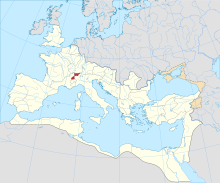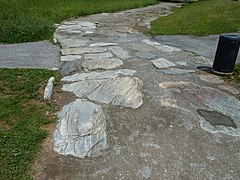Alpes Graiae et Poeninae
| Provincia Alpes Graiae et vallis Poenina Provincia Alpes Atrectianae et vallis Poenina | |||||||
|---|---|---|---|---|---|---|---|
| Province of the Roman Empire | |||||||
| 41/54 AD–476 | |||||||
 The Roman Empire c. 125 AD, with the province of Alpes Graiae et Poeninae highlighted | |||||||
| Capital | Forum Claudii Ceutronum (Alpes Graiae/Atrectianae) Forum Claudii Vallensium (Alpes Poeninae) | ||||||
| Historical era | Antiquity | ||||||
• Created by Claudius | 41/54 AD | ||||||
• Deposition of Romulus Augustulus | 476 | ||||||
| |||||||
| Today part of | France Italy Switzerland | ||||||
The Alpes Graiae et Poeninae, later known as Alpes Atrectianae et Poeninae (officially Alpes Atrectianae et Vallis Poenina), was a small Alpine
The province had two capitals, most likely since its creation: Forum Claudii Ceutronum (modern-day
Name
The province was commonly called Alpes Graiae, Alpes Atrectianae, Alpes Graiae et Poeninae, or Alpes Atrectianae et Poeninae, as a shortened form of its full name. In some documents, the province is also named Alpes Poeninae et Graiae, or Alpes Poeninae.[3]
It may have been known as the Alpes Graiae et Vallis Poenina at the time of its creation,
According to Livy, the name Alpes Poeninae derives from an indigenous deity named Poeninus,[7][8] who is attested as Poininos on local inscriptions and in the name Jupiter Poeninus.[9] It survives in the modern form Pennine Alps, as does Vallis Poenina in the name Valais.[10] Xavier Delamarre has proposed to similarly see a theonym *Graios (found in Herculi/Herculeio Graio) in the name Alpes Graiae.[11] The name Alpes Atrectianae may derive from a local kinglet called Atrectius, just like the Alpes Cottiae are named after Cottius. While his existence is not attested, the cognomen appears in the name of four governors of the province from the 2nd and 3nd centuries AD.[3]
History
The region of Vallis Poenina, corresponding to the modern
The Vallensian tribes were granted
During the reign of Diocletian (284–305), the province was integrated into the praeses of the Diocese of Gaul.[6][13] Some scholars date the unification of the Alpes Graiae and Alpes Poeninae to this period rather than the reign of Claudius.[1] In 381, the first Bishop of the region, Theodul, was mentioned. After the Fall of the Western Roman Empire, the region was invaded by the Burgundians and incorporated into their kingdom. After its fall, it was integrated into the Frankish Kingdom in 534, then briefly invaded by the Lombards in 574.[13]
Gallery
-
Amphitheater in Martigny
-
Roman road in Martigny
-
Traces of the amphitheater in Aosta
-
Aosta theater
-
Triumphal arch in Aosta
References
- ^ a b c Wiblé 1998, pp. 186–188.
- ^ ISBN 978-3-11-039485-6.
- ^ a b c d Wiblé 1998, pp. 188–189.
- ISBN 978-3-925355-13-4.
- ^ Bérard 1995, p. 348.
- ^ a b c Graßl 2006.
- Ab urbe condita, 21:38.
- ^ Appolonia, Lorenzo (2008). Alpis Poenina - Grand Saint-Bernard: une voie à travers l'Europe. Projet Interreg IIIA. pp. 24–25.
- ISBN 978-1-74332-695-4.
- ISSN 1047-7594.
- ISBN 978-1-7980-5040-8.
- ^ a b Wiblé 1998, pp. 186–187.
- ^ a b c Frei-Stolba 2014.
- ^ Frei-Stolba 2014: "Ebenfalls unter Claudius wurde die V. von der Provinz Raetia et Vindolicia getrennt und wohl gleichzeitig unter einem gemeinsamen Statthalter mit den Alpes Graiae (auch Alpes Atrectianae) zu den Alpes Graiae et Poeninae vereint."
Primary sources
- ISBN 978-0674992566.
- ISBN 978-0674991231.
Bibliography
- Bérard, François (1995). "Un nouveau procurateur à Aime en Tarentaise: Savoie" (PDF). Gallia. 52: 343–358. JSTOR 43599248.
- Historisches Lexikon der Schweiz.
- Graßl, Herbert (2006). "Alpes Graiae". Brill's New Pauly. .
- Wiblé, François (1998). "Deux procurateurs du Valais et l'organisation des districts alpins". Antiquité Tardive. 6: 181–191. ISSN 1250-7334.






